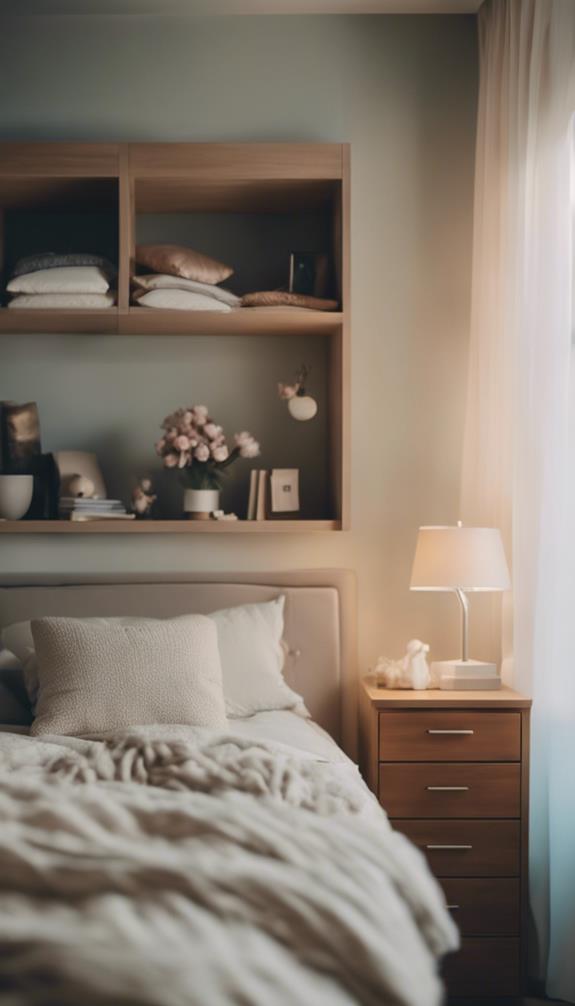As you stand in your kid's bedroom, surrounded by toys, clothes, and chaos, you can't help but feel overwhelmed. You've tried tidying up, but it seems like no matter how hard you try, the clutter always comes back. It's time to take a step back and rethink your approach. By implementing a few simple strategies, you can help your kid develop good habits and a sense of responsibility for their space. From categorizing toys to establishing a bedtime routine, there are many ways to create a more organized and peaceful environment. But where do you start?
Decluttering and Purging Toys

As you stand in the midst of your child's bedroom, surrounded by toys scattered everywhere, it's clear that decluttering and purging is long overdue.
You're not alone in this struggle, but it's time to take control.
Start by gathering boxes or bins and categorizing toys into groups like building blocks, dolls, and action figures.
This toy categorization helps you see what you're dealing with and makes it easier to decide what to keep and what to let go of.
Be honest with yourself – if your child hasn't played with something in months, it's probably safe to get rid of it.
Use sentimental sorting to separate items with emotional value from those without.
This will help you make tough decisions and create a more organized, peaceful space for your child to grow and thrive.
Assigning a Home for Each Item
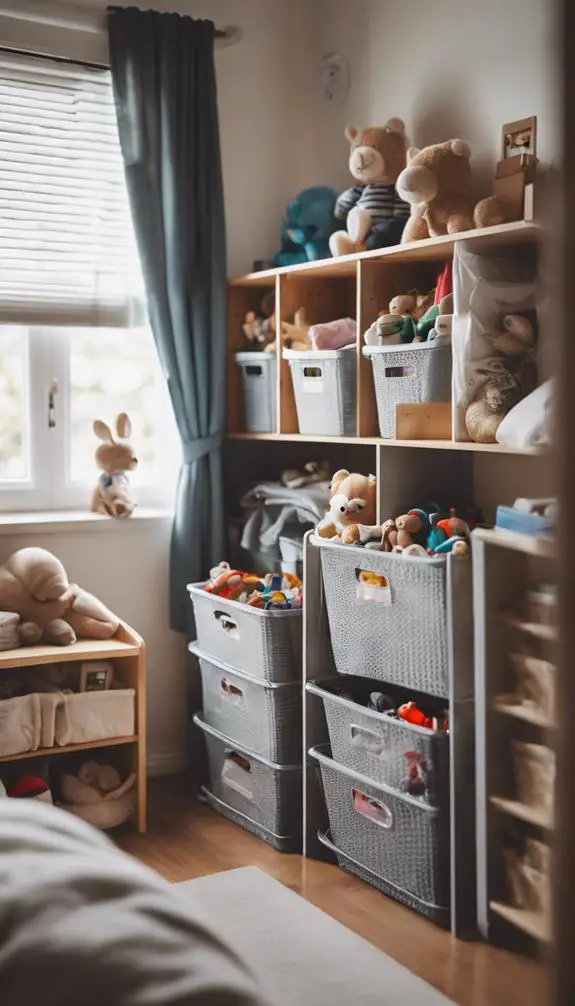
You're now ready to give each item in your kid's bedroom a designated spot, making it easier for them to find what they need and put things back in their place.
This means assigning a home for toys, books, clothes, and accessories, and making sure your kid understands where each item goes.
Designate a Spot
Your child's bedroom can quickly become a cluttered chaos without a system in place.
Designating a spot for each item is key to maintaining order. Think of it as creating a "spot saver" for every toy, book, and trinket. This means assigning a specific place for each item, making it easy for your child to find what they need and put things back where they belong.
For example, designate a "toy haven" for stuffed animals, a bookshelf for reading materials, and a desk organizer for school supplies. By doing so, you'll help your child develop good habits and a sense of responsibility, keeping their bedroom tidy and organized.
Label Everything
Labeling everything in your child's bedroom helps them quickly identify where items belong, making it easier to maintain the organization system you've established.
Invest in a label maker to create clear and concise labels for storage bins, shelves, and drawers. Consider color coding labels to categorize items, such as blue for toys, red for art supplies, and green for books.
This visual system will help your child quickly understand where items belong. Labeling also encourages your child to put things back in their assigned spot, developing a habit of tidiness and responsibility.
Creating a Bedtime Routine

As you create a bedtime routine for your kids, you'll want to start by getting them ready for bed, which includes tasks like brushing teeth, changing into PJs, and using the bathroom.
Establishing bedtime boundaries is also vital, such as setting a consistent bedtime and creating a calming pre-sleep atmosphere.
Get Ready for Bed
A calm and tidy bedroom signals to your child that it's time to wind down, making the shift to bedtime a whole lot smoother.
Establishing a consistent bedtime routine helps your child develop healthy sleep habits. Create a sleep schedule that works for your family, and stick to it, even on weekends.
A bedtime routine can include activities like brushing teeth, reading a book, or singing a lullaby. Encourage your child to get ready for bed at the same time every night, so their body gets used to the routine.
Establish Bedtime Boundaries
Set clear expectations for bedtime by creating a routine that works for your child.
Establish a consistent sleep schedule and stick to it, even on weekends. Develop a calming pre-sleep routine, like reading a book or taking a warm bath, to signal that it's time for bed.
Set screen time limits and impose an electronic curfew to avoid stimulating activities before bedtime. Designate a "tech-free zone" in the bedroom to promote relaxation.
Using Storage Bins and Baskets

You're probably no stranger to the chaos that can ensue when kids' toys, clothes, and accessories start piling up in their bedroom.
To regain control, turn to storage bins and baskets. They're a simple yet effective way to keep clutter at bay.
Start by categorizing items into groups, such as toys, clothes, and books. Then, assign each group a designated bin or basket.
Use bin organization to store items like building blocks, dolls, or action figures. For softer items like stuffed animals or blankets, opt for a basket arrangement.
Place the bins and baskets in easy-to-reach locations, making it simple for your kids to put things back in their place. By doing so, you'll create a sense of order and make cleaning up a breeze.
Labeling and Signage System

You'll create a labeling and signage system that helps your kids quickly identify where things go, making cleanup a breeze.
Start by establishing label categories that make sense to your child, such as "Toys," "Books," and "Clothes."
Next, you'll create storage bin labels and clear shelf signs that match these categories, ensuring everything has a designated spot.
Label Categories
With a clear plan in place, it's time to create a labeling and signage system that helps your kids quickly identify where things belong in their bedroom.
To start, decide on the main categories you want to label, such as "Toys," "Books," "Clothing," and "Art Supplies."
Use a label maker to create clear, easy-to-read labels for each category. Consider using color coding to differentiate between categories or to indicate which toys are for sharing and which are personal.
For example, you could use red labels for toys that need to be put away after playtime and blue labels for toys that can stay out.
This system will help your kids develop good habits and maintain their newly organized space.
Storage Bin Labels
Next, assign labels to storage bins and containers that hold items within each category.
This step is vital in maintaining bin organization and ensuring your kid can easily find what they need.
When designing your label, keep it simple and concise. Use a font that's easy to read, and consider adding icons or images to make it more visually appealing.
You can use a label maker or create your own labels using stickers or printable labels. Be specific with your labels, for example, "Building Blocks" or "Dress-up Clothes".
This will help your kid understand what's inside the bin without having to dig through it. By implementing a clear label design, you'll encourage your kid to put things back in their place, maintaining a clutter-free bedroom.
Clear Shelf Signs
A well-organized bedroom relies heavily on a clear labeling and signage system, and clear shelf signs are a crucial component of this system.
You can create custom signs that match your kid's bedroom theme, making it more engaging and fun for them to maintain their space.
Use shelf dividers to separate toys, books, or clothes, and label each section with a clear shelf sign.
This visual system helps your kid quickly identify where items belong, encouraging them to put things back in their place.
By implementing clear shelf signs, you'll reduce clutter and make cleaning up a breeze.
It's an innovative way to teach your kid the importance of organization and responsibility.
Teaching Kids to Put Away Toys
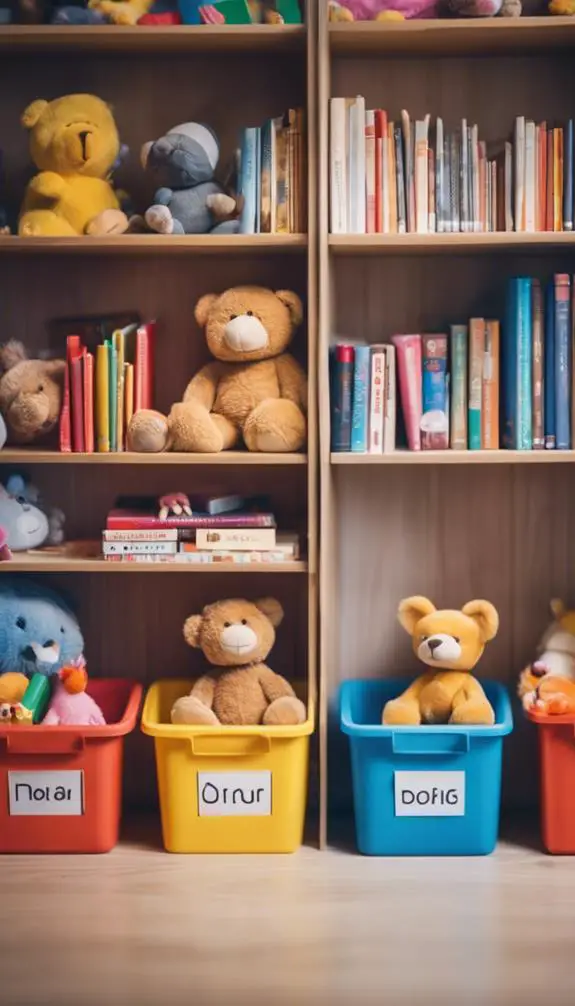
Teaching your kids to put away their toys is a crucial step in maintaining a tidy bedroom, and establishing this habit from a young age is imperative.
By incorporating toy habits into their daily playtime routine, you'll set them up for success. Start by designating a specific time each day for toy cleanup, making it a non-negotiable part of their playtime routine.
Encourage your kids to put away one toy before taking out another, helping them develop a sense of responsibility and ownership over their belongings. Make it fun by turning cleanup into a game or creating a reward system for a job well done.
Consistency is key, so stick to the routine and watch your kids develop good toy habits that will last a lifetime.
Making the Most of Closet Space

Now that your kids have learned to put away their toys, it's time to think about where they're storing them.
Maximizing closet space is key to keeping their bedroom organized. Start by installing double rods to instantly double their hanging space.
Use closet dividers to separate different types of clothing or to create a section for out-of-season items. This keeps similar items together, making it easier for your kids to find what they need.
Consider using shelves or bins for folded items like t-shirts and sweaters. By optimizing their closet space, you'll help your kids develop good habits and keep their room clutter-free.
Establishing a Laundry System
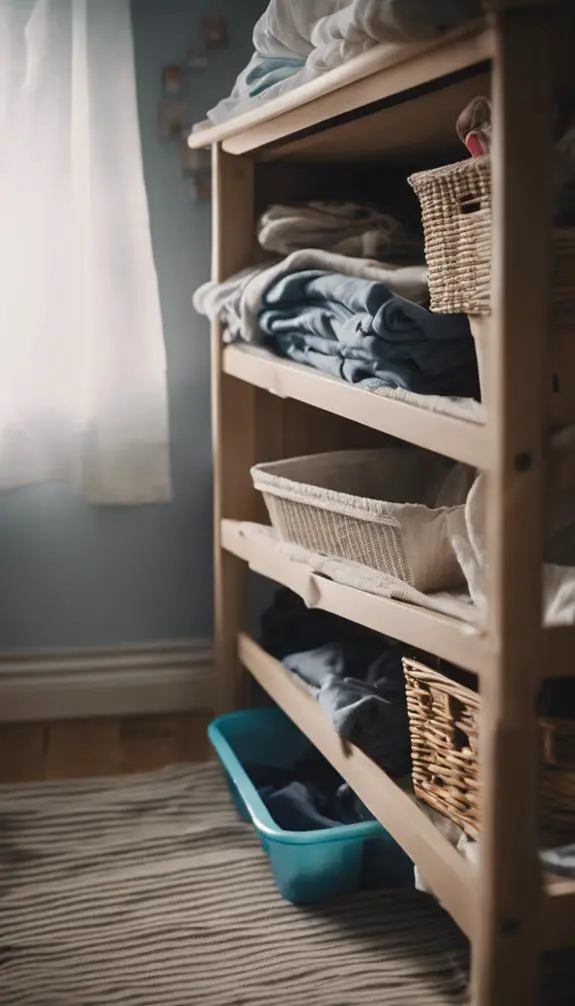
Your kids' bedroom is starting to take shape, and their closet is becoming a model of organization.
Now it's time to tackle the laundry system. You can't ignore the dirty piles that seem to magically appear on the floor.
Invest in a laundry sorter or a divided hamper to separate lights from darks and delicates from everyday clothes. This simple step will make doing laundry a breeze.
Teach your kids to put their dirty clothes in the designated sorter or hamper, and make it a habit to empty it regularly.
This system will help maintain the cleanliness of their bedroom and create a sense of responsibility in your kids.
Designating a Homework Station

With the laundry system in place, you're freeing up time and energy to focus on another crucial aspect of your kid's bedroom: a designated homework station.
This dedicated space helps develop good homework habits and encourages your child to stay focused.
When setting up the station, consider your child's study style and needs.
Do they prefer a quiet corner or a collaborative space?
Certify the area is well-lit, comfortable, and equipped with necessary supplies.
A clutter-free desk, a good chair, and a bulletin board for reminders can make a big difference.
Utilizing Vertical Wall Space
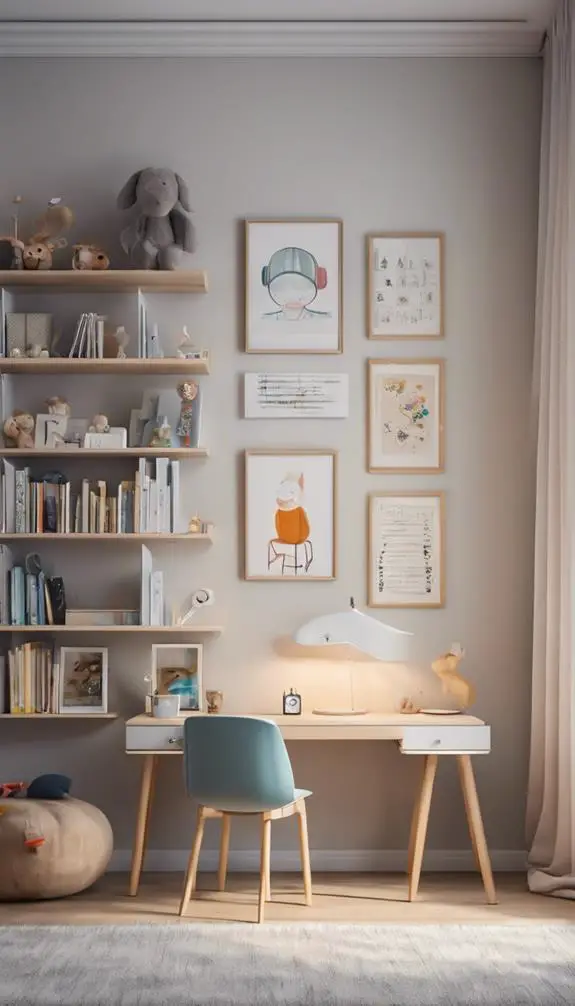
Beyond the homework station, the walls of your kid's bedroom offer a wealth of untapped potential.
You can maximize this space by installing wall shelves, which provide ample storage for books, decorative items, and other knick-knacks.
To keep items organized and easy to find, use shelf dividers to separate and categorize your kid's belongings.
This will help keep clutter at bay and make the most of the available vertical space.
Implementing a "One In, One Out" Rule

Every item that enters your kid's bedroom should have a counterpart that leaves to maintain a balanced amount of possessions and prevent clutter buildup.
This "one in, one out" rule guarantees that new additions don't lead to overwhelming clutter. When your child receives a new toy, consider which old one can be donated or discarded to make space for it.
This approach encourages responsible consumption and helps your child appreciate the value of each item. Implementing toy rotation can also help. By regularly switching out toys, you can keep things fresh and exciting for your child while preventing boredom and the desire for more.
This rule helps your child develop healthy relationships with their belongings and maintain a tidy bedroom.
Encouraging Daily Maintenance

By implementing the "one in, one out" rule, you've set the stage for a more organized bedroom.
Now, it's time to encourage daily maintenance habits to keep the space tidy. Establish morning routines that include making the bed, putting away toys and books, and putting dirty clothes in the hamper.
These daily habits will help your kids develop a sense of responsibility and ownership over their space. Encourage them to take a few minutes each day to maintain their room, putting things back where they belong.
This will help prevent clutter from building up and make cleaning easier. By incorporating these habits into their daily routine, your kids will develop good habits that will last a lifetime.
Creating a Reward System
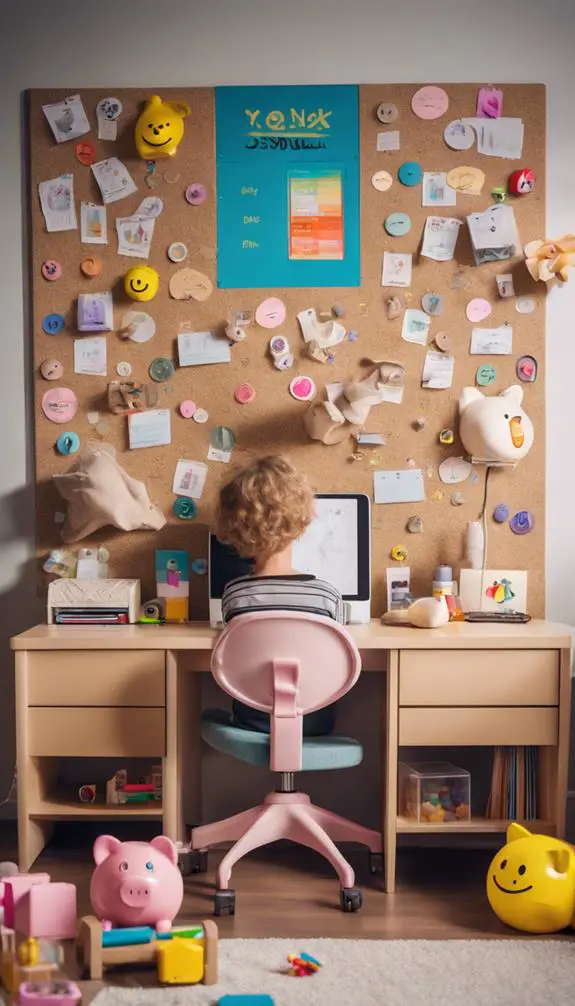
To take their daily maintenance habits to the next level, set up a reward system that motivates your kids to keep their room organized.
Create a Star Chart with specific tasks, such as making their bed, putting away toys, and keeping the floor clear. Assign points or stars for each task completed, and establish Reward Levels that grant special privileges or treats.
For example, five stars could earn extra screen time, while ten stars could mean a fun outing or a favorite meal.
Make the system transparent and fun, and involve your kids in setting the goals and rewards. This won't only encourage them to maintain their space but also teach them valuable skills like responsibility and goal-setting.
Frequently Asked Questions
How Do I Handle Sentimental Items My Child Is Attached To?
When dealing with sentimental items your child is attached to, you'll need to navigate their emotional connection. Try Sentimental Sorting, where you categorize items into keep, display, and store piles, and consider Memory Keeping strategies like shadow boxes or digital archives to preserve memories.
What if My Child Resists the New Organized Bedroom Setup?
When your child resists the new organized setup, you'll face child resistance and potential power struggles. You'll need to stay calm, empathize, and involve them in decision-making to make adjustments and find a compromise that works for both of you.
Can I Involve My Child in the Organization Process From Start to Finish?
You're wise to involve your child in the organization process from start to finish, promoting child empowerment and personal responsibility, as they'll learn to make decisions, take ownership, and develop essential life skills through active participation.
How Often Should I Reorganize and Reassess My Child's Bedroom?
You'll want to schedule frequency checks every 2-3 months to maintain your child's space, and consider seasonal refreshes to reinvigorate their room and teaching them to adapt to changing needs and habits.
What Are Some Organization Methods for Kids With ADHD or Special Needs?
You'll find success with kids having ADHD or special needs by implementing visual schedules to establish routines and using adaptive storage solutions like labeled bins and shelves that cater to their unique needs and learning styles.
Conclusion
You've taken the first steps towards a clutter-free kid's bedroom! By implementing these simple organizational strategies, you'll help your kids develop good habits and a sense of responsibility. Remember, maintaining a tidy space is an ongoing process. Stick to your routine, and don't be too hard on yourself if things get messy again. With time and consistency, your kids will learn to keep their room organized, and you'll all enjoy the benefits of a peaceful and productive space.




